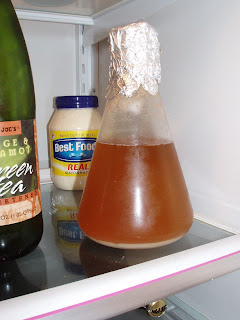So I stepped up to building a frozen yeast bank. I copied some steps from somewhere a while back (maybe HBT), but just tried harvesting from my last brew (Pacman). Basically I sanitize 15ml vials and lids, add about 3-4 ml glycerin. After racking off the cake I used a pipette to fill the vials to about 80% so I'm guessing maybe 8ml of slurry. Then freeze. To use, I pull it out in the morning to let it warm up 4-6 hours. Then I made a 1 cup starter with 2 oz DME (I only realized after the fact that it was 1.092 and I was supposed to do 1oz). Then after 24 hours I added 1L + 4.3oz DME (1.047). For a grand total of 1.055 which is still a bit high so maybe some stress there. I don't have a stirrer yet and just shake it regularly and keep a gel heating pack under it for warmth. The steps said to treat the larger starter like any other starter, so another 24-30 hours. After another 48 hours though, there is no krausen or bubbling in the airlock except when it's being shaken. There does seems to be an increasing white layer at the bottom when it settles.
Questions:
Is this sort of time table normal when coming from such a small amount of frozen yeast?
Could the high starter gravity cause a slower start?
Is there something I can do to improve speed this up without reducing quality?
How can you tell when your starter is ready?
Questions:
Is this sort of time table normal when coming from such a small amount of frozen yeast?
Could the high starter gravity cause a slower start?
Is there something I can do to improve speed this up without reducing quality?
How can you tell when your starter is ready?




